New York City’s Museum of Modern Art wasn’t designed to readily accept the life’s work of Björk Guðmundsdóttir—a trait it shares with most of the world, which isn’t always inclined to embrace music that is challenging, vibrant and on occasion utterly outside the realm of mainstream pop. So when curator Klaus Biesenbach set out to exhibit the Icelandic iconoclast’s voluminous portfolio of visual and sonic art, he had to modify the building. To accommodate the resonating bass notes in a specially commissioned video for “Black Lake,” a song from Björk’s latest album, Vulnicura, “we had to build a new floor,” Biesenbach says, “to keep our Picassos from falling off the walls.”
The installation at MOMA, on display from March 8 to June 7, spreads over three floors, encompassing the photographs, music videos, costumes and custom-made instruments that have helped make Björk, 49, a singular pop presence since she emerged from Iceland with the Sugarcubes in 1987. Biesenbach pursued the singer for five years before she agreed to the retrospective. “It’s tricky for a musician to be in a visual museum,” she says. “To take someone on a musical journey, like a musician’s development, how you change in 20 years’ time. That’s the experiment.”
The singer sat down with TIME a few weeks before the retrospective was scheduled to open at MOMA. She chose a small cafe on a hidden-away street in Brooklyn Heights, where she keeps one of her three homes. (The other two are in Iceland and London.) Sipping tea and wearing a bright white parka, platform nurse’s shoes and a brilliant yellow dress that seemed decidedly springlike on a gray winter day, Björk was typically specific and eloquent about what inspired the images that photographers, directors, costumers, fashion designers, graphic designers and makeup artists have crafted for her.
Each is part of its own chapter in Björk’s impressive catalog of musical identities. Here, she weighs in on 12 of the most arresting works to be displayed at MOMA.
The Face Magazine, 1993 (Photograph by Glen Luchford)
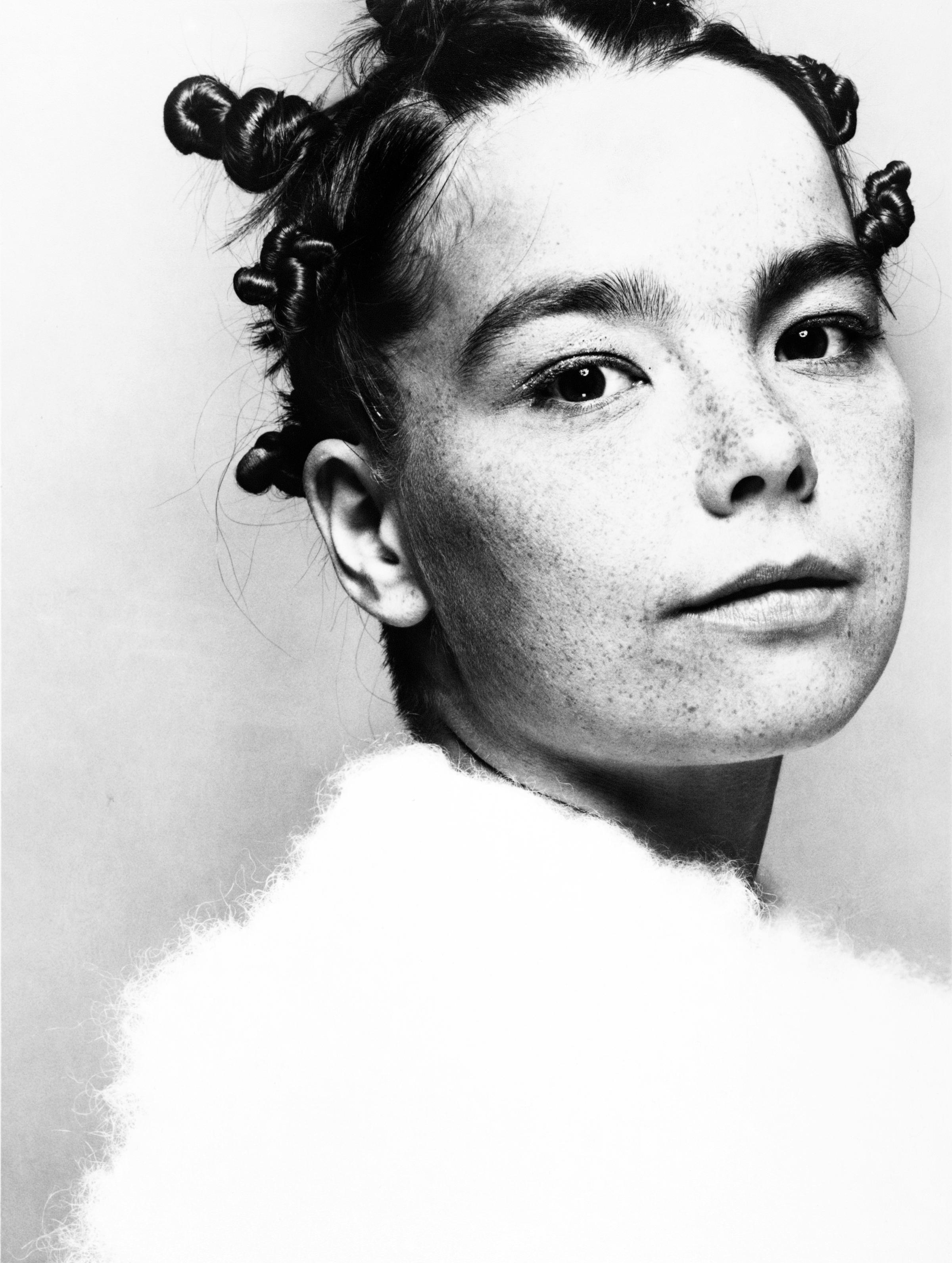
Glenn Luchford did this photo. He’s amazing with skin. The camera was literally like this big—so you get all these details. I was 27 when this was taken. It’s very much when I moved first to London—I was a bit crazy, a single mom. I moved with my son [Sindri], he was 6 at the time. Found him a school, rented a flat. And I just found that all the people that were exciting me musically were living in London and it was just a mission I really had to go on. I started going to raves a little bit back in Manchester in ’89, hanging out with 808 States and Graham Massey. And then it wasn’t til ’93 that I moved to London, had that white fluffy—I wore this all the time, white mohair, like a bomber jacket. Very rave.
I had met Dom T, who was a DJ and my boyfriend at the time. He was from Bristol. And I’d met Nellee Hooper, who was the producer of the [Debut] album. I didn’t know at the time that he would end up producing it—it was one of those things. I actually started working with Graham Massey [of 808 State], from Manchester. But then as I got to know Nellee, we slowly just did the whole thing together.
I never wanted to be world-famous. I’ve always been a music nerd. I really love, and get high on, when there’s a flow in a group, sort of energy. I don’t know what it’s called in English. When a group works really well together. That’s my drug. I don’t know what it’s called. Some energy that happens. When everybody is kind of equal, and opened-up, and the clocks go away, and there’s just a sort of flow.
I was in bands from when I was 15. I preferred being in a group. But I think what happened to me—the music in the band I was in [The Sugarcubes] wasn’t my taste. I love the people in it—we still text each other all the time. We all run this label in Iceland called Bad Taste, and they’re still like my best mates. But as a music nerd, I just had to follow my heart, and my heart was those beats that were happening in England. And maybe what I’m understanding more and more as I get older, is that music like Kate Bush has really influenced me. Brian Eno. Acid. Electronic beats. Labels like Warp. And if there’s such a thing in pop music as a Music Tree, I see myself on the same branch, you know. And for me it’s almost like you know, I’ve been calling it ‘matriarch electronic music.’ So I think that was the heart I was following.
I just wanted to meet likeminded music people. And I definitely met those. Like Talvin Singh and Leila Arab—a lot of immigrants. I think basically most of the people I was hanging out with were immigrants. And Talvin Singh is from India, so I was tapping into the whole Bollywood thing. That ended up being two songs on this album, with strings recorded in India. Talman Singh was going to India anyway, and he took two songs on a DAT [Digital Audio Tape recorder] to the film studios there, and they recorded strings on two songs, “Venus As A Boy” and “Come To Me.” And then he came back and just put it on the tracks. So everything was very spontaneous. Just driven by love of music, really.
Video for “Human Behavior,” 1993 (Directed by Michel Gondry)
When [Michel Gondry and I] first met, we did a song that was a little bit about my childhood. It took me 10 years to work it out that we had almost similar moms and really similar childhoods. All the videos we’ve done, they’re always about my childhood, nostalgic in a way. And then when I had to do [videos for] grownup songs, I’d have to go somewhere else. And then I’m always teasing Michel that he has to do a grownup song. We kind of have an ongoing joke about that. I think with people like Matthew Barney and Chris Cunningham, and also maybe Inez and Vinoodh, I had the opportunity to tap into the adult side of me. And also with Nick Knight, I think the work we’ve done has been less childish. I like both.
Homogenic, 1997 (Album cover photograph by Nick Knight, costume by Alexander McQueen)

After Homogenic, I would say I pretty much picked all the garments that I wore on my sleeves [album covers]. But in this one, I pretty much walked into a relationship that was between Nick Knight and Alexander McQueen. They had already done a few images that were quite feisty, and were kind of experimenting. In those years, you didn’t really do stuff digitally like that. Nick Knight has been such a pioneer in those things. But I explained to Lee—that’s what we call him in England, Alexander McQueen—that for me Homogenic was an album that had this contrast in it. Because I had just done two albums, Debut and Post, where I traveled the world, and did interviews, and became this representative of Iceland. And it was almost like a cliché, like I was this elf, eskimo from up North, which wasn’t true, you know?
And I went to Spain and wrote this album. And I tapped into what I felt truly was Icelandic. It wasn’t the cliché. It was more romantic Icelandic strings and the beats on this album are distorted, they sound like volcanoes. That for me is very patriotic. But at the same time, I was saying to Lee, I’m like the most global citizen from Iceland. When I’m in Iceland, I’m like the cosmopolitan, you know. When I’m in New York, I’m like the Icelandic person. So it’s an interesting contrast.
So my idea was to call the album Homogenic, which was about how I’m from one place, but I wanted this to be from 10 different places. So this is like, Indian, no this is from Africa, this is Mexican, this is Japanese, this is European manicure and then the eyes are kind of robot contact lenses. So for a lot of people this image passed off as a Japanese thing, maybe because of the background, but we were trying to make up a person, a warrior queen, that was from every culture. But I didn’t come up with this. It was Alexander McQueen’s idea.
Video still from All Is Full of Love, 1999 (Directed by Chris Cunningham)
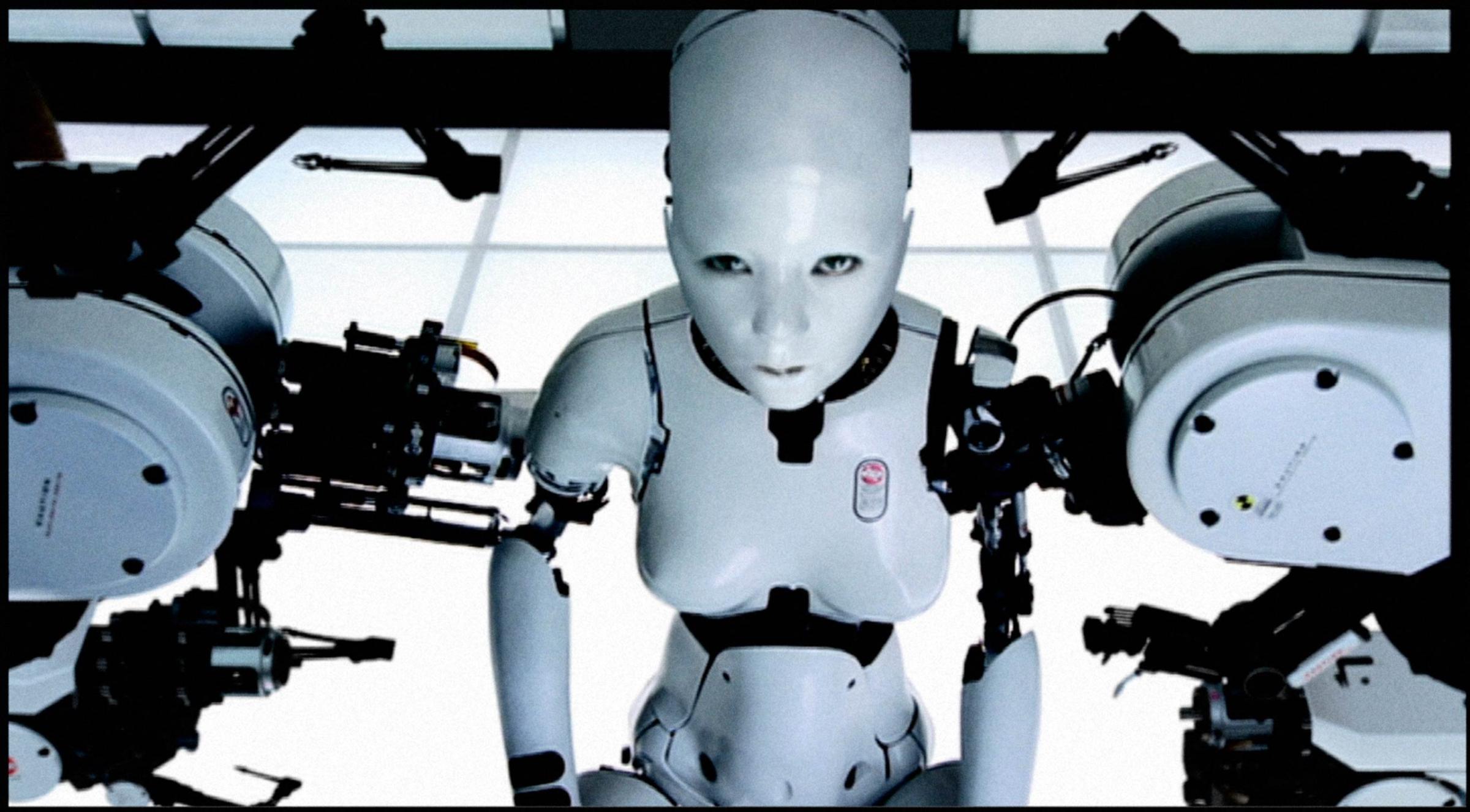
This video has a different story than most other things I’ve done. I obviously was a huge fan of [Chris’s] work. And then it wasn’t until I got the right song that I was like, “OK, this is something that’s very Chris, that has that melancholy and that sensual and emotional depth.” I told him that this song is sort of about where love and lust meet. It’s sort of like heaven. It’s quite erotic. But it’s in heaven so everything has to be white. And then I gave him these little statues that I bought—you know these Chinese ivory statues, this small, that are like erotic? I bought quite a few of them and gave them to him.
And then a week or two later, he sent me a treatment where he included all this work he had done on robots, that happened to be something he’d been doing for years, and he’s like, “I think these two could meet.” It’s almost like a modern version of the little figurines.
He thought it would take three months, and it just wasn’t ready. So I have to change and put another outfit on, and become the protector. I have to kind of hold off the record companies and become a producer. They spent nine extra months doing this video with hundreds of interns working for free, because we didn’t have any budget. I’m not really a No. 1 artist, you know.
This took him a long time to finish. I was just like, I trust you. You know when you just know that something really amazing is happening, you just feel it in your stomach? And you just gotta protect it, like a feisty mom. So I just become a feisty mom, and created space for him. And he showed me this and it was next level. Chris just needs his bubble to create.
Swan Dress, 2001 (Designed by Marjan Pejowski)

TIME: Will the infamous, notorious swan dress be there?
Björk: The swan dress? Yes. With the eggs. They were almost going to put a red carpet, but then, somebody talked us out of that. It would have been funny, though.
Volta, 2007 (Album cover photograph by Nick Knight, costume by Bernard Wilhelm)

I was working with Bernard Wilhelm to make the outfits for the Volta tour, and we were meeting several times. And he showed me this thing. And I was like, “Wow, we gotta make this. That is absolutely ridiculous. It’s like totally slapstick.” What I’m wearing is plastic. He had never made something like that before. He found some people who spray cars [for the paint]. It was quite a journey. I’m so glad we get to exhibit it in MoMA.
And we were like, “What kind of photographer is good at [shooting something like this]?” Nick Knight is just so good at photographing something that’s that streamlined and make it more powerful. For me it was almost like two covers of Volta, that one is the yang, the male, and [the other one, by Inez and Vinoodh] is more the female—all the crochet, what’s inside, like the intestines of the character.
Volta, 2007 (Alternative album cover photograph by Inez and Vinoodh)
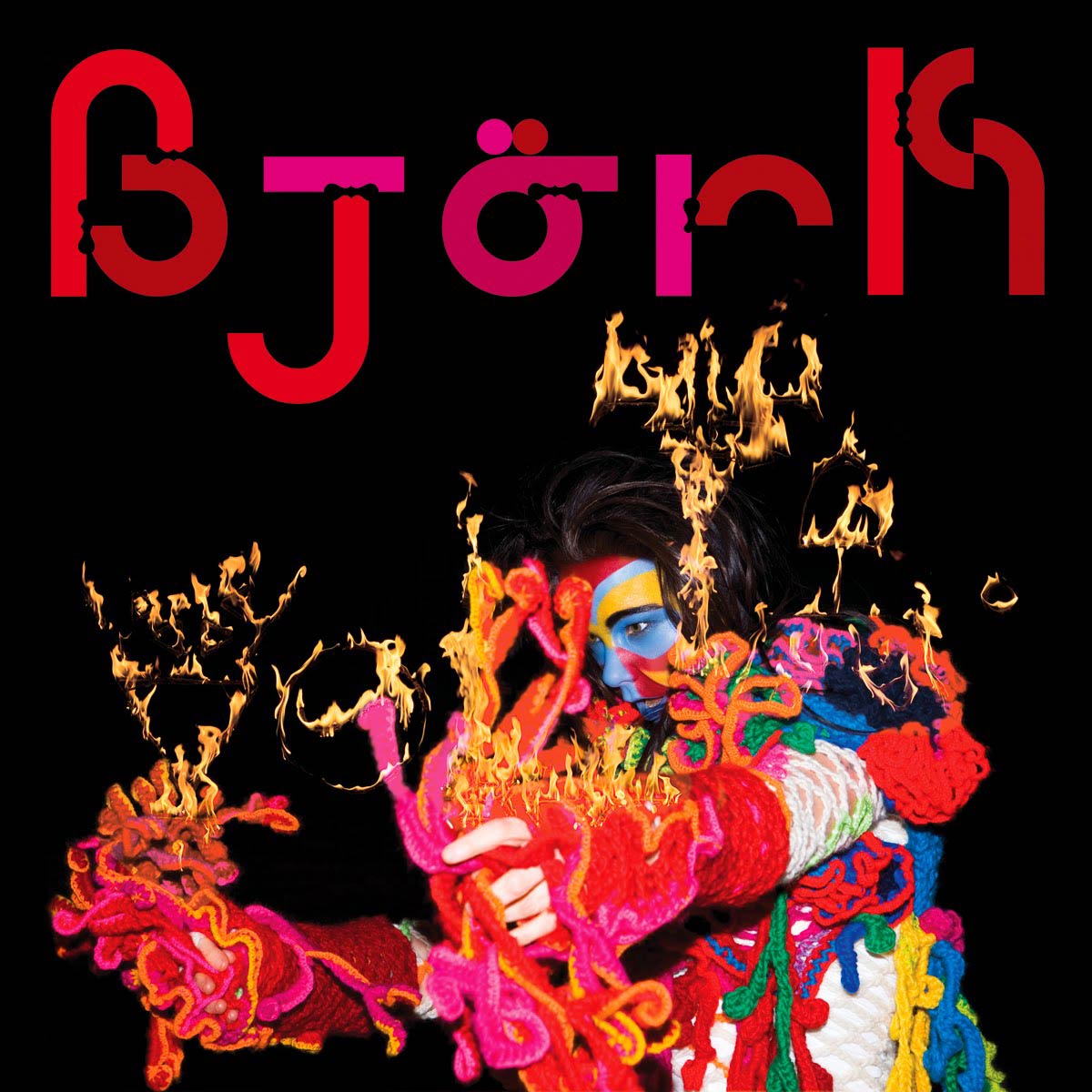
The first thing I always know—maybe it’s a musician thing—I always know the colors pretty early. And it’s like solving a murder mystery. I knew it was red, and then electric blue and neon green. The makeup reference funnily enough came from Bernard Wilhelm, because I was working with two people at the same time for this. Sometimes it’s like an overlap, you know? But we were trying to make up this character who is kind of in some invented tribe. And then M/M, the designers, they came up with a fire font for “Volta.” They actually made pipes, and put gas in it, and photographed it, making letters, a fire font.
Video still from “Wanderlust,” 2008 (Directed by Encyclopedia Pictura, costume by Icelandic Glove Corp.)

There’s always one song on each album that’s the heart of the album. I was living on a boat at the time, trying to figure out in what country we were gonna live in. And it was really about this nomad feeling, you know. So we talked about nomads and it was Encyclopedia’s idea immediately to go for the Himalayas, and this kind of aesthetic. I felt it would’ve been a bit obvious to do the Icelandic thing because I wanted it to be more universal.
For the Volta character, I started quite early working on this. I contacted girlfriends of mine, they’re like a collective called Icelandic Glove Corporation. They’re friends of mine in Iceland. I wanted to make this nomadic shaman voodoo Icelandic woman, who was a feminist and kind of pagan. So we made up this character with several outfits where they would just crochet it like mad.
Biophilia, 2011 (Album cover photograph by Inez and Vinoodh)
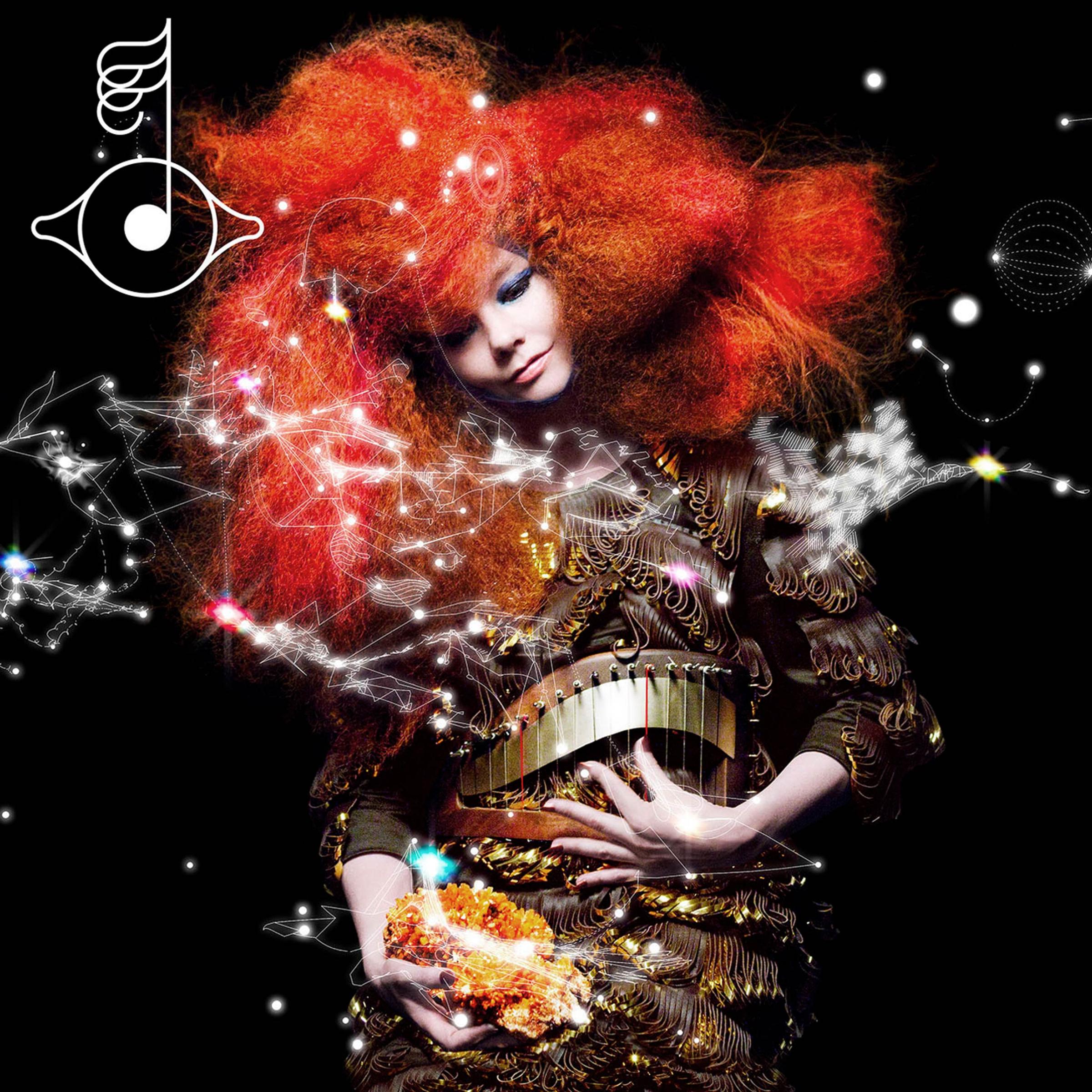
I’ve got a really amazing relationship with the photographers, Inez and Vinoodh, who I’ve worked with now for like 16 years, 17 years. I actually just came from them now, just seeing the new video they’ve done for me. I’m like, almost in tears. They really made it happen again. They’re so understanding of me. I’m really grateful for their vision. I’m able to mirror myself in them.
This is actually a really typical thing that happens. I will arrive and say, “I want big orange hair, it has to be like a cloud, this woman has her head in the clouds, almost a piss-take, of this kind of music teacher, kind of trippy. Who takes the kids in her class on this utopian journey through the galaxy, teaching them psychology. So she has to be a bit nuts.” So I kind of asked for a big orange Afro and I brought some dresses that I collected. And then my friends from Three as Four, they’re clothes designers, they live here in New York, friends of mine since 2000. They brought this harp, and I asked if we could bring crystals. I just made up this nutty music teacher who’s trying to unite nature and music.
M/M, the guys who designed my album cover, were really understanding, too. They came up with this galaxy here, and this logo. And they worked a lot with the photographers. So it’s kind of teamwork. I maybe go out hunting and bring the ingredients and throw them on the table, but then everybody cooks together the meal. I’m not really good—I once tried to photograph myself. But I hated it because it’s so narcissistic. I can’t get my head around it. And like the selfie thing, I’m not from that generation or something. And also there’s something catalyst that happens when you work with amazing photographers and a design team. They just put in the magic and the yeast, and make it all work.
Video for “Mutual Core,” 2012 (Directed by Andrew Thomas Huang)
This is for Mutual Core. This is based on the tectonic plates. Andrew always gets these weird requests from me. I kind of gave him a color palette and asked that it be sort of about the two tectonic plates, and how we are making them work together. And it was all about geology in a way. But I think that’s the reason I contacted Andrew Huang in the first place. Because he did this amazing video, I’m not gonna remember what it’s called now, you have to Google it, it wasn’t for a band or anything. He was working a lot with sand and deserts. So it was totally like, “Wow, we are overlapping here.” I’m so happy because he’s also doing two other videos for me now. He’s done three videos on this album [Vulnicura]. He’s been amazing.
Onstage at Bonnaroo, 2013 (Photograph by Danny Clinch)

This was shot a year and a half ago when I was doing concerts. What [MOMA curator Klaus Biesenbach] was realizing—something that I don’t realize, of course—is that I will have a character for each album. For me it’s almost like a tarot card. Each album character is on the cover. But then there’s always an in-between two characters. So this is like when the Biophilia dress isn’t there anymore—they were all in this copper color or electric blue—and the dress had become white. But it’s still a little bit Biophilia.
This would [also] be the beginning of Vulnicura. But for me this photo is very much about forgiveness. What’s nice about the spines is that they’re very light, very easy to wear. I quite like how lo-fi it is. But I also like that it connects with something quite spiritual or saintly. And I think every human being has a potential inside them, that if they managed to forgive, it has this saint-like flavor. But I’m not saying I’m good at it, I’m not an expert at all, but I do try. It is definitely something I was tapping into here, definitely in the “Black Lake” song, it’s about the concept of forgiveness. And a lot of saints through the ages, their theme is if you manage to just forgive, it’s liberating. It’s the only way to salvation. And it’s very much between you and yourself at the end of the day.
Video still from “Black Lake,” 2015 (Directed by Andrew Thomas Huang)
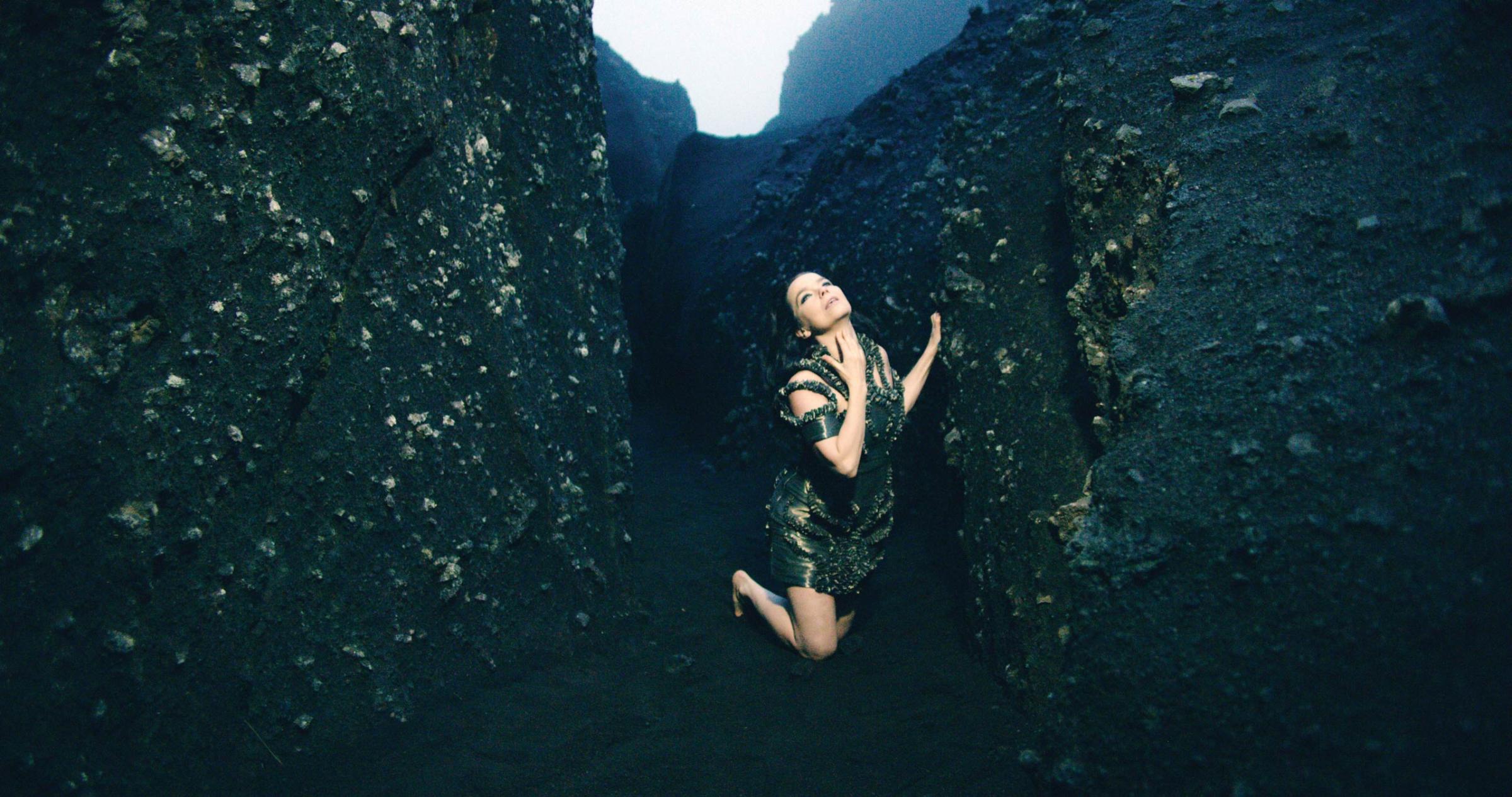
Andrew Huang, the director, came to Iceland and we were looking for this scene. It’s like the wound is being healed. So we were trying to find cliffs that we shaped like a wound, so I could be inside the wound. Iris Van Helpen is an incredible craft designer. She designed most of the dresses for Biophilia. She did this dress that is metallic, and is kind of like lava.
People say Biophilia is like —it’s like my sci-fi album. This is my very psychological, in-my-apartment album. I say that tongue in cheek, don’t take that too seriously. It’s funny. So that was sort of the language we were trying to find.
The video goes through several different landscapes, but the story is kind of, spatially, told in the landscape. It’s kind of tight—this is quite tight. This is not the tightest one. And then it’s a resolution. Well at least we try for some sort of healing and liberation. I don’t know if you’ve seen the lyrics, but the last verse is about healing. And the last shot is sort of like a space shuttle. Kind of like when you see the space rockets, going out like the NASA ones. I like that.
It’s been one of the longest relationships I’ve had, with Andrew. Because of MoMA, it wasn’t just a three-month, four-month music video process. He came into the picture almost a year ago and we’ve had like a hundred meetings. It it becomes like a bureaucracy thing when you do it with art museums. But this is how it ended up.
More Must-Reads from TIME
- Donald Trump Is TIME's 2024 Person of the Year
- Why We Chose Trump as Person of the Year
- Is Intermittent Fasting Good or Bad for You?
- The 100 Must-Read Books of 2024
- The 20 Best Christmas TV Episodes
- Column: If Optimism Feels Ridiculous Now, Try Hope
- The Future of Climate Action Is Trade Policy
- Merle Bombardieri Is Helping People Make the Baby Decision
Contact us at letters@time.com